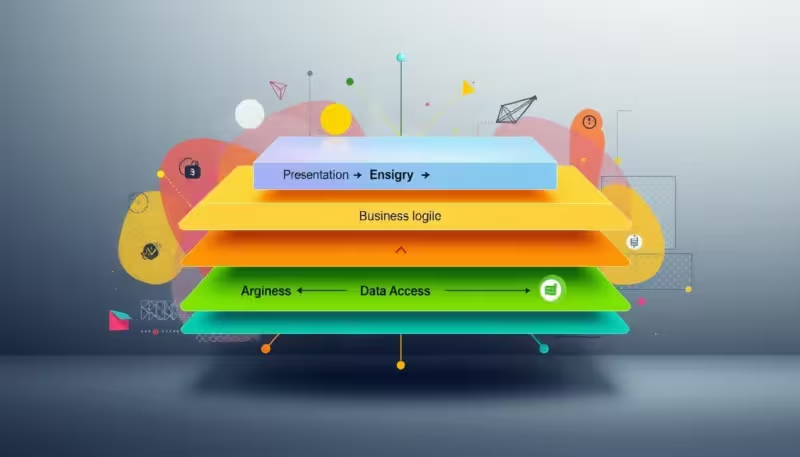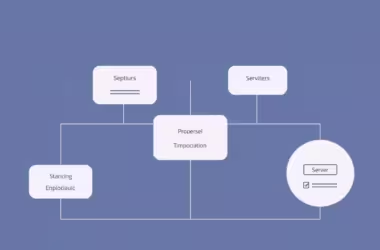In software development, Layered Architecture stands out. It’s a software design pattern that divides an app into different layers. These layers make the code easier to handle, update, and expand. This is key for making robust systems. Developers can then build apps that are both sturdy and flexible.
The idea behind layered architecture is simple. Each layer only talks to the layer directly above or below it. It’s like a cake with many layers. This clear division makes the code more organized. As apps get bigger, having several layers—from three to more—shows the benefits of this design.
This guide will show you how using Layered Architecture helps teams. They can manage complex systems better. It makes developing software smoother and leads to better products.
Introduction to Layered Architecture
Layered Architecture is key in software engineering. It divides application components into different layers that only talk with nearby layers. This method creates a clear hierarchy. It allows for little impact on others when one layer changes. Thus, it’s great for big applications with complex needs.
The Overview of Layered Architecture shows how it enables testing each layer by itself. This improves testing of single units and boosts the system’s reliability. Despite its benefits like flexibility, it can face issues like extra workload and slow communication. These points mark it as a favorite in software architecture patterns.
Layered Architecture supports changing needs, offering design flexibility. Applications might have different layer counts, but they usually have key sections like the user interface, business processes, and data storage. Its modular design leads to varied yet efficient software development methods.
What is Layered Architecture?
Layered Architecture is a way to build applications. It divides an app into different layers: Presentation, Application, Domain, and Infrastructure. Each one has its own job and talks mostly to the layers next to it. This setup goes with software principles that like a modular structure. It lets developers work on one layer without messing up the others. The clear split helps organize things better. It also makes it easier to change stuff as the app grows.
The definition of Layered Architecture shows the importance of each layer:
- Presentation Layer: Takes care of the user interface and how people interact with the app.
- Application Layer: Handles the business logic and the flow of the application.
- Domain Layer: Holds the business rules and deals with data.
- Infrastructure Layer: Looks after storage and talks to outside systems.
Layered Architecture is good for apps with up to 200 users and not many changes after launching. Setting it up doesn’t cost much. But, there are things to watch out for. Changes in one layer can affect others, making scaling and updating tricky. As apps get bigger, having many layers might slow things down because it takes longer to process requests.
Since the 1980s, Layered Architecture has changed a lot. It went from simple two-tier setups to more complex three-tier ones. These changes have made it great for big projects and enterprise apps. It also makes it easier to switch from a single large app to smaller services. The ability to scale and reuse parts of the app is why developers like this design.
Benefits of Implementing Layered Architecture
Layered Architecture is valuable in many areas, especially in software development. It helps clearly separate different parts of the software. This separation means that changes in one area don’t affect the others much. This setup reduces bugs when software is updated, a common problem in many systems.
It makes software easier to maintain. Developers can change or update parts without redoing the whole system. This makes updates simpler and code easier to understand. Projects become easier to manage. The system also supports reusing code and scaling up, meeting growing business needs well.
- The implementation of Layered Architecture in the e-commerce sector has been linked to a 30% decrease in system downtime.
- Healthcare organizations report a 20% reduction in development costs due to improved modularity.
- Financial services have experienced a 30% increase in transaction processing speed, showcasing notable software development benefits.
This approach is especially key in big systems with many teams. It keeps development unified. Layered Architecture offers strong, up-to-date solutions, showing its critical role in modern software.
Key Components of Layered Architecture
Layered Architecture is a method for designing systems. It uses essential layers to increase modularity, maintenance ease, and the ability to scale. The structure of Layered Architecture usually consists of five main parts:
- User Interaction Layer: Manages how users interact with the software.
- Functionality Layer: Helps users move through various sections smoothly. It acts as a link.
- Business Rules Layer: Sets the rules for how each section behaves.
- Application Core Layer: Is the heart of the software, making everything run.
- Database Layer: Keeps and looks after the data needed by the software.
Each part of Layered Architecture works on its own. This means a developer can update parts without affecting others. This makes the system very adaptable. It meets the needs of many different uses.
Even though Layered Architecture brings many benefits like better organization and the ability to grow, it can also make things a bit complex. It might slow down the system because of the extra steps in processing. However, for larger apps, the pros are much bigger than the cons.
Choosing the Right Language and Framework
When building applications using Layered Architecture, the programming language and framework you choose matter a lot. Python, Java, and C# are popular choices. The right framework can make development smoother and improve the app’s performance. It’s common for developers to pick frameworks that help simplify the process of creating complex apps.
Popular Frameworks for Layered Architecture
Some frameworks are especially good at supporting Layered Architecture:
- Python with Django – Django is great for quick development, offering powerful tools and libraries for scalable apps.
- Java with Spring – Perfect for big company apps, Spring provides a lot of options and a big ecosystem.
- JavaScript frameworks like Node.js – Node.js is loved for its fast development times, thanks to its non-blocking architecture.
- C# with ASP.NET – Ideal for web apps, focusing on maintainability and safety.
Factors to Consider When Choosing
There are important selection criteria for frameworks to think about:
- Development Speed: Look at how fast you can go from idea to launch with a framework.
- Community Support: A large community offers lots of help, from documentation to third-party libraries.
- Available Libraries: Check for libraries that add features quickly, lessening the need for writing code from scratch.
- Alignment with Project Requirements: Make sure the framework fits the app’s specific needs and goals well.
- Team Expertise: Pick a framework your team knows well to make the development process easier.
Defining the Layers in Layered Architecture
Understanding the layers in Layered Architecture helps us see how they work together. Each layer has unique functions that make a system more modular and easier to scale. The main layers include presentation, application, domain, and infrastructure. They all play special roles in the architecture.
Presentation Layer Responsibilities
This layer is where users interact with the system. It focuses on showing data and getting user inputs. Main tasks are:
- Creating a user-friendly interface.
- Implementing techniques using HTML, CSS, and JavaScript.
- Ensuring seamless user experience across different devices.
Application Layer Roles
This layer acts as a bridge. It connects user actions to the system’s core business logic. Its main jobs are:
- Processing requests and managing workflows.
- Coordinating between the presentation and domain layers.
- Providing services rather than directly manipulating data.
Domain Layer Functions
The domain layer is the heart of the system’s logic and rules. Its crucial duties include:
- Defining the key business logic and algorithms.
- Representing what the system accomplishes.
- Delivering substantial value to business operations.
Infrastructure Layer Importance
This base layer keeps the application stable and reliable. It handles:
- Managing data access and connections to external resources.
- Providing crucial services such as logging and security.
- Monitoring system performance to uphold reliability.
Implementing Error Logging in Layered Architecture
Error logging is key for keeping applications healthy and performing well in a layered setup. It’s really important because it gives us deep insights into how applications act. These insights help find and fix exceptions and issues efficiently. By logging errors well, developers can make systems more reliable.
Why Error Logging is Crucial
Error logging is crucial because it makes solving problems easier. When issues pop up, logs show the flow through different layers. This helps teams figure out problems across different areas like the UI and Business Logic Layers. Logging errors with clear tags at the right spots improves problem tracking. Also, logging smartly avoids duplicate entries that can slow things down.
Steps to Set Up Error Logging
Setting up logging is straightforward with the right tools. For example, Django supports it well. Here are the main steps for strong error logging:
- Configure loggers and handlers: Do this in the settings file to control error outputs.
- Strategically place log calls: Put log statements in key parts, especially where errors might happen. This helps catch issues from deep layers like the Persistent Layer.
- Use unique identifiers for traceability: This method makes tracking errors across requests or systems easy.
- Adopt domain-oriented observability patterns: Use error handling methods that match your application’s setup to track and log errors better.
- Evaluate logging frameworks: Choose a logging framework like Serilog or NLog for a more scalable and flexible approach.
Throttling and Rate Limiting in Layered Architecture
In today’s digital world, throttling in APIs and rate limiting techniques are key. They help keep the online space safe and running smoothly. Using these approaches, we can control API requests to prevent misuse and keep systems running well.
Throttling controls how many requests are made to an API over time. It keeps traffic at a level that won’t overload users. This is common with services that use public data or operate on platforms like AWS.
Rate limiting, however, handles user access. It sets limits, like only 20 new accounts per day from one IP address or restricting messages with certain keywords. These steps fight off harmful attacks. When limits are passed, users get a HTTP Status Code 429 Too Many Requests message.
- Client-side strategies like exponential backoff are helpful in dealing with API rate limits.
- There are a few main types of rate limiting:
- User-Level Rate Limiting
- Server-Level Rate Limiting
- Geography-Based Rate Limiting
While both throttling and rate limiting can affect how a system runs, they do it in different ways. Rate limiting needs to watch traffic every second. Throttling just looks at each request, which is easier on performance.
To wrap things up, knowing and using throttling and rate limiting is very important. They make APIs in a layered setup more secure and reliable. This ensures fair use of resources and a good experience for everyone.
Real-World Examples of Layered Architecture
Layered Architecture is widely used in many fields, showing its strengths in various case studies. A key example is when the Spring Boot and Java 11 are used together. This setup splits the architecture into three main layers: controllers, services, and repositories.
This approach allows developers to build elements like Shelf and Book. They demonstrate a One-to-Many relationship. This makes applications easier to maintain and scale. Repositories act as a bridge to the database, in this case, PostgreSQL, by extending JpaRepository or CrudRepository.
The use of SOLID principles gives a clear structure. It is seen in the ShelfService interface and ShelfServiceImpl. These parts handle tasks such as making shelves and getting data. Hibernate is used for creating tables, providing a reliable way to manage data from different sources.
Layered Architecture also benefits multi-tier applications. It separates distinct areas for each tier. Data flows smoothly between layers with Java for the back end and JavaScript with Angular for the front end. These uses of Layered Architecture show how it’s versatile and effective for creating systems that are both scalable and easy to keep up.
Best Practices for Building Robust Systems
To get the best results, following Layered Architecture guidelines is key. It’s important to clearly define how layers interact. This makes communication smooth and clear. Also, keeping layers separate means changes in one don’t mess up the rest. This separation is key to making strong systems.
Using a test-driven development approach helps make layers reliable and stable. Having thorough documentation helps too. It makes sure everyone knows their role, making maintenance easier. This helps future development go smoothly.
It’s good to regularly check how the system is performing. This helps find any problems early. Using these practices makes systems stronger and better in many ways. They lead to software that’s easier to scale, maintain, and efficient.
Conclusion
Layered Architecture is key in making software, especially for big projects. It lines up parts like presentation and application into clear layers. This setup helps keep things organized and makes working together easier.
This method is both simple and consistent, making software easier to test. But, it can get complicated if there are too many layers. Since the 1990s, this way of building software has stayed important. It changes as needed without losing its main ideas.
Last thoughts on Layered Architecture focus on its power to create lasting software. Following best practices, like logging errors well, helps teams use this design successfully. This approach boosts performance and prepares software for the future.






